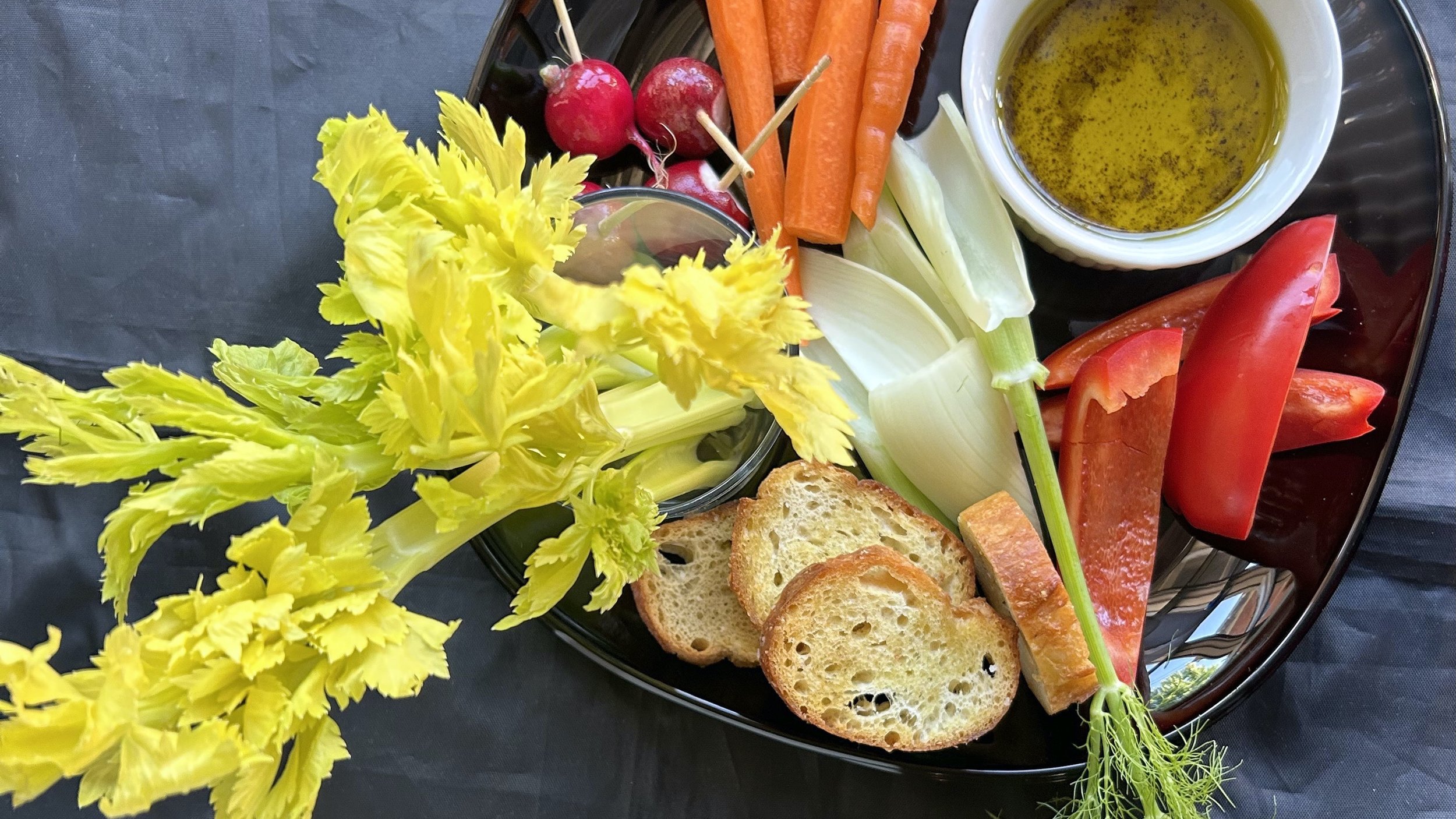AN OLIVE OIL PRIMER
A simple but terrifically delicious recipe for Pinzimonio follows the story about olive oil below.
We tend to think of olive oil as something to measure out in cups, to fry or sauté with, for example, or as a significant component in a splashy salad dressing.
But good-quality olive oil - especially that earning the rank of “Extra Virgin Olive Oil” - is more a condiment than anything else, to be spooned or sprinkled rather than glugged from the bottle.
That's because good oil is prized less as a medium for cooking than for the taste or savor of its unique flavor points.
As wines are reflections of their grapes, olive oils are likewise. The taste and aroma of an olive oil is the sensory mirror of the variety of olive from which it is made, where and how those olives grow, and the way that the oil is made.
For example, the famous Taggiasca olive of Liguria, Italy, makes for an oil that is so much like melted butter that you'd be forgiven for thinking it so: sweet, soft, with flavors of almond and cashew. In those ways, it is distinct from the more "green," peppery oils of Tuscany, themselves reflections of different olive cultivars grown there.
And so, many a Ligurian olive oil is delicious as a dribbled-on topping for foods where you might also enjoy melted butter: on poached fish, for instance, or in an Italian vegetable dip called pinzimonio, or for dipping fingers of steamed artichoke leaves, or - well, wherever melted butter might otherwise be.
At the table, condiments vary in purpose; so do wines. So, too, do extra virgin olive oils. Some are soft and mellow, while others are pungent and peppery. Hence, some work better over heat and as a medium for cooking, while others taste best when used apart from cooking, strictly as a condiment, just for adding flavor.
Here is a short guide to the places extra virgin olive oils (EVOO) have in and out of the kitchen.
As wines are reflections of their grapes, olive oils are likewise. The taste and aroma of an olive oil is the sensory mirror of the variety of olive from which it is made.
Soft and Mellow
These EVOOs resemble melted butter, with aromas and tastes of nuts like macadamia or raw cashew. They’re ripe Golden Delicious apple to other EVOO’s arugula.
Many southern French or Provencal EVOOs are Soft and Mellows, as, to repeat, are those from Italy’s Liguria. Some California EVOOs are this way, too.
Use these EVOOs just as you’d use butter: for drizzling on cooked fish, for instance, or for a quick sauté of mushrooms or vegetables.
Fruity and Smooth
These EVOOs are a bridge between the Soft and Mellows and the next group, those that are Pungent and Peppery. They’re easy-going and buttery, but a taste of them often finishes with a snap, as if you were eating ripe avocado sprinkled with both chopped cilantro and lime juice.
In the kitchen and on the table, these are versatile EVOOs. They come from many different sorts of olives, and from many places, from Greece to Spain to California.
Use them for baking (olive oil cake!), for sautés, or as a dip for bread. They’re great for salad dressings or as a “sauce” for grilled vegetables or meats.
Pungent and Peppery
These robust, even fiery, EVOOs play a special role with food. While they taste like liquid green olive, their piquant bite or “finish” on the palate is like eating a leaf of sorrel or arugula.
As such, use these oils sparingly - but deliciously - precisely for their intense flavors, as a brush on grilled lamb, for example, or for a drizzle on slices of summer tomato.
They’re certainly not for frying or sautés and may be too much in a salad dressing, but they are the great condiment of the EVOO family.
Many Tuscan oils are Pungent and Peppery, as are other Italians, many Spanish EVOOs and several from California and Greece.
Use your absolutely best extra virgin olive oil—with abandon—for this recipe.
Marcella Hazan told me, one Aspen Food & Wine Classic, that the Italian word "pinzimonio" is a combination of the Italian verb "pinzare" (to pinch; you pick up the raw vegetable pieces with your fingertips) and "matrimonio." You "marry" the crudités with the best possible, freshest extra virgin olive oil. That's all.
For the raw vegetables, many possibilities, including or other than those in the recipe below: stalks of celery and their leaves (the tenderest and palest possible); radishes, rough stems and roots pared away, stuck with decorative toothpicks as holders; fennel, cleaned of its feathery top and sliced into half-moons, tender stems remaining attached if desired; carrots, peeled (the slimmest and tenderest possible); red bell pepper, de-veined and seeded, cut into strips. Other possibilities: Persian cucumbers, partially peeled and sliced longways into fourths; scallions ("green onions"), cleaned and root ends trimmed off; leaves of Belgian endive or thin radicchio.
RECIPE: Pinzimonio
Ingredients
Stalks of celery (the tenderest and palest possible)
Radishes, with stems attached
Fennel, cleaned of its feathery top and sliced into half-moons
Carrots, peeled (the slimmest and tenderest possible)
Scallions, trimmed at the two ends
Extra virgin olive oil
Sea or kosher salt
Pepper mill
Directions
Line a very large basket with white toweling and arrange the vegetables in it. Give everyone a plate and an individual small bowl filled with 2-3 tablespoons olive oil. Each person can flavor the oil with salt and ground pepper (and a few drops of lemon juice, if desired). The idea is to dip the vegetables in the oil and eat.

